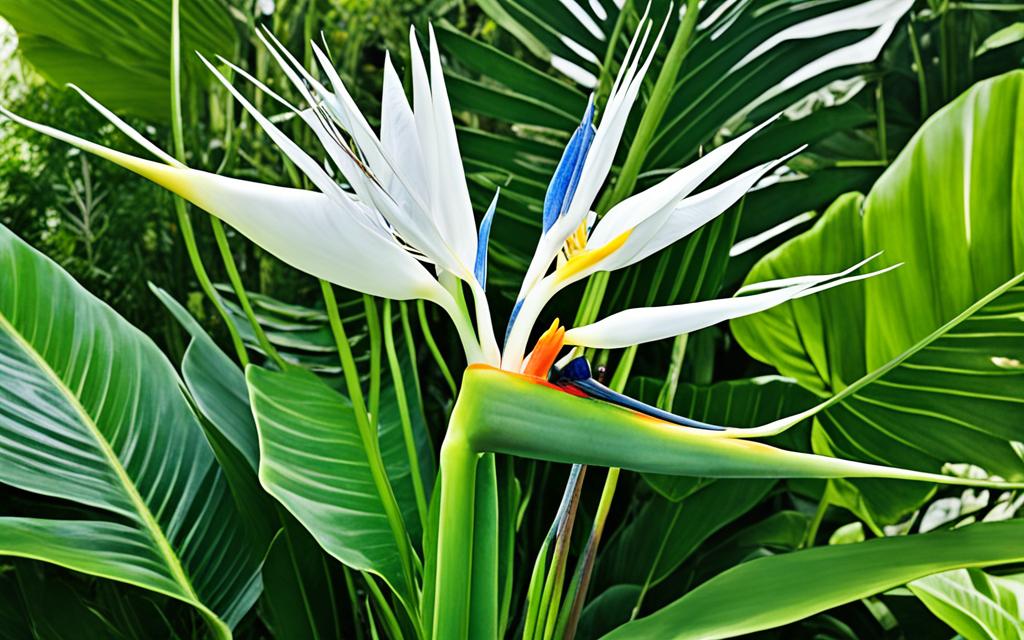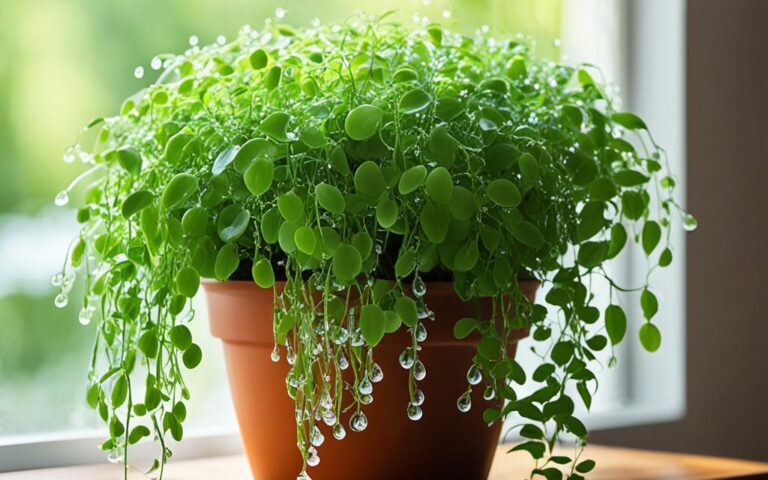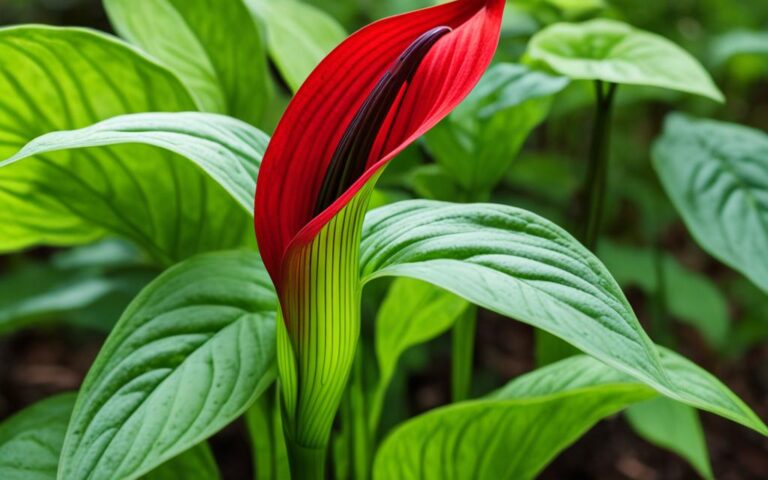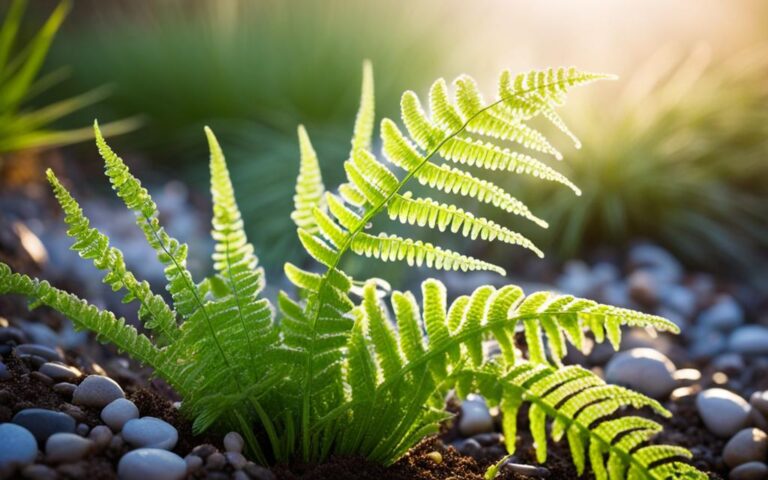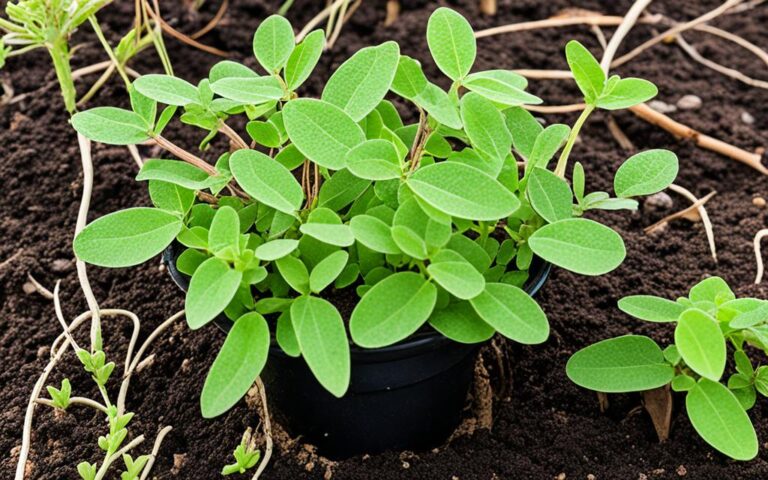White Bird of Paradise Plant: Stunning Tropical Beauty
Did you know the White Bird of Paradise plant can reach up to 8 feet tall indoors? It’s a favorite for indoor spaces, known for its big, banana-like leaves and unique white flowers. These flowers look like a bird in flight, adding beauty to any room. With the right care, it’s easy to keep this plant happy and thriving indoors.
Key Takeaways
- The White Bird of Paradise is a striking tropical plant with large, banana-like leaves and unique white flowers.
- It is a popular choice for indoor spaces, known for its low-maintenance and drought-tolerant nature.
- The plant can grow up to 8 feet tall indoors, making it a dramatic and impressive addition to any room.
- With proper care, the White Bird of Paradise can thrive and add a touch of lush, exotic beauty to your home.
- Integrating this plant into your interior decor can bring a touch of the tropics and a sense of sophistication to your living space.
Introduction to the White Bird of Paradise Plant
The White Bird of Paradise plant has become very popular in recent years. It’s loved in homes, offices, and gardens worldwide. This tropical plant comes from the sunny parts of South Africa. It’s known for its eye-catching look and can thrive indoors or outside.
Popularity and Importance
People who love plants, designers, and homeowners all adore the White Bird of Paradise. Its blooms look like a crane in flight, and its big leaves stand out. It’s great for cleaning the air and can grow quite tall, up to 20 feet in the wild.
This makes it a top choice for those who enjoy tropical houseplants and exotic plant varieties.
Interesting Facts
- The White Bird of Paradise plant, also known as the Strelitzia reginae, comes from South Africa’s warm, subtropical areas.
- It can grow up to 20 feet tall in the wild, but indoor plants are usually shorter.
- Its flowers look like a crane’s head, which is why it’s called the White Bird of Paradise.
- The plant has big leaves that look like bananas, adding to its exotic look.
- The Strelitzia reginae was named after Queen Sophie Charlotte of Mecklenburg-Strelitz, showing its royal and unusual plant features.
“The White Bird of Paradise plant is a true showstopper, captivating all who encounter its stunning blooms and lush foliage.”
Species and Varieties of White Bird of Paradise
The White Bird of Paradise, known as Strelitzia reginae, is a popular choice for gardens. It’s part of the Strelitzia genus, which includes other interesting species. Each one has its own special features and ways of growing.
Common Species
The Strelitzia genus also has the Strelitzia nicolai, or Giant White Bird of Paradise. It can grow up to 20 feet tall. This makes it perfect for big gardens in USDA Hardiness Zones 10 to 12.
The Strelitzia alba, or Cape Wild Banana, can reach 30 feet tall and has white flowers. The Strelitzia caudata, or mountain wild banana, grows in southern African mountains. It can also get as tall as 20 feet.
Unique Characteristics
- The Strelitzia reginae, or Orange Crane Flower, is the most grown species. It grows 5 to 6 feet tall.
- Strelitzia juncea, or the Rush-Leaved Strelitzia, is about 6 feet tall and does well in dry places.
- The Strelitzia × kewensis, a mix of S. reginae and S. alba, is no longer grown. It has disappeared from gardens.
These different Strelitzia species give gardeners and homeowners many choices. They can pick the perfect White Bird of Paradise plant for their space and climate. From tall giants to smaller plants, each brings its own beauty to gardens.
Anatomy of the White Bird of Paradise Plant
Leaves and Stems
The White Bird of Paradise plant (Strelitzia reginae) has large, paddle-shaped white bird of paradise plant leaves. These leaves can grow up to 2 feet long and 1 foot wide. They have a waxy texture and a vibrant green color, making the plant look lush and green indoors.
The strelitzia plant stems are strong and can grow tall, holding up the plant’s big tropical plant inflorescences. The stems are green, smooth, and slightly glossy.
Flowers and Special Features
The White Bird of Paradise plant is known for its unique, bird-like white bird of paradise plant flowers. These strelitzia plant blooms come from boat-shaped bracts and have white and blue or orange colors. They look like a crane’s head, which is how the plant got its name.
Aside from its beautiful flowers, the White Bird of Paradise has other special features. It can grow tall and has big, tropical-looking leaves. These features add to its beauty.
| Characteristic | Details |
|---|---|
| Native Origin | The white bird of paradise plant (Strelitzia reginae) is native to South Africa. |
| Plant Size | The plant forms a 3- to 5-foot-tall clump. The S. nicolai (white or giant bird-of-paradise) grows to 15-30 feet. |
| Flower Production | Healthy, mature plants can produce as many as three dozen flower spikes a year. Bird-of-paradise tends to produce more flowers along the outside of the plant. |
| Growth Rate | Bird-of-paradise is considered a slow-growing plant. A bird-of-paradise grown from seed will take three to five years to bloom. |
| Lighting Needs | For good flower production, place plants in sunny or partially shaded locations. The bird of paradise plant requires nearly full sun in the summer and as much light as possible in winter to bloom best. |
| Propagation | Bird-of-paradise is easily propagated by division, with clumps divided into single-stem divisions. The germination period for bird of paradise seeds can take up to 8 weeks or more. |
“The success of a new planting depends on adequate moisture during the establishment period.”
Ideal Growing Conditions for White Bird of Paradise
The white bird of paradise plant loves bright, indirect light. It does well near east- or west-facing windows. But, it should not get too much direct sunlight, especially for young plants, to prevent leaf burn.
Keeping the soil consistently moist is key for the tropical plant cultivation. The white bird of paradise needs moist soil all year, especially in spring and summer. Make sure the soil drains well to avoid waterlogging, which can cause leaves to turn brown and crunchy.
The indoor plant environments best for the strelitzia have temperatures between 65°F to 85°F (18°C to 30°C). The lowest temperature it can handle is about 60°F (15°C). Keeping the humidity high is also important, as this plant loves humid climates.
It’s a good idea to clean the leaves often to get rid of dust and help the plant absorb sunlight better. The white bird of paradise usually doesn’t have pests, but spider mites can be a problem. These pests can be controlled with a light soapy solution.
By meeting the white bird of paradise plant‘s growing requirements, you can help it grow well and look great. This makes it a beautiful addition to any indoor or outdoor space with a tropical theme.
White Bird of Paradise Plant Propagation Methods
There are several ways to grow the beautiful White Bird of Paradise plant. Division and offsets are quick and reliable. Seed propagation is slower but can be very rewarding.
Division is the best way to spread the White Bird of Paradise. You need to split the plant’s rhizomes or offsets carefully. Make sure each piece has roots. Do this in late winter or early spring when the plant is growing well.
- Division is very successful and helps new plants grow quickly.
- Offsets, small plants that grow near the main plant, can also be moved to pots to start new plants.
For a challenge, try seed propagation. It takes years for the plants to grow and flower. Seeds need to soak in warm water for 24-48 hours before planting. Germination can take weeks to months.
| Propagation Method | Success Rate | Time to Maturity |
|---|---|---|
| Division | High | Immediate |
| Offsets | Moderate | Intermediate |
| Seed Propagation | Variable | Long |
Choosing how to propagate the White Bird of Paradise is up to you. But, make sure the new plants get enough sunlight, good soil, and the right food. This helps them grow strong and bloom beautifully.
Care and Maintenance Essentials
Caring for the white bird of paradise plant is simple with a few key steps. Regular pruning keeps the plant looking great and growing well. Remove dead, damaged, or discolored leaves to keep it in top shape. Proper training helps shape the plant, guiding it to grow in a certain way. This might mean staking or tying the stems for support as it grows. With the right care, the white bird of paradise plant will flourish and be a beautiful addition to any space.
Pruning and Training Techniques
When pruning the tropical plant, focus on removing dead, damaged, or discolored leaves. This keeps the plant looking good and encourages new growth. Training the indoor plant with staking or tying helps shape its form. It also ensures it grows in the direction you want as it gets bigger.
Pests, Diseases, and Remedies
The white bird of paradise plant is usually easy to care for but can face pests and diseases if not looked after. Issues like spider mites, aphids, and mealybugs can be fixed with insecticidal soap or neem oil. If the plant shows signs of leaf discoloration or crunchy leaf edges, it might be due to overwatering, underwatering, or extreme temperatures. Fixing these plant health issues quickly and following good watering and care practices will keep the white bird of paradise plant healthy.
“The white bird of paradise plant represents freedom, beauty, and magnificence.”
| Common Pests | Symptoms | Remedies |
|---|---|---|
| Spider mites | Webbing, stippling, and discolored leaves | Insecticidal soap, neem oil |
| Aphids | Curled, distorted leaves, sticky residue | Insecticidal soap, predatory insects |
| Mealybugs | White, cottony masses on leaves and stems | Isopropyl alcohol, neem oil |
Watering Needs and Soil Requirements
Keeping the right moisture balance is key for the white bird of paradise plant to thrive. In spring and summer, it needs regular watering. Make sure the soil stays moist but don’t let it get too wet, allowing water to drain well from the pot.
When fall and winter come, you can water less often. Let the top inch or two of soil dry out before watering again. This helps the plant adjust and prevents root rot or fungal diseases from overwatering.
The white bird of paradise plant likes soil that drains well and is full of nutrients. A mix with peat, perlite, or sand works best for its growth indoors or outside.
Knowing what the strelitzia soil needs and tropical plant moisture requirements helps gardeners care for their white bird of paradise plant. Following a regular indoor plant watering schedule keeps this beautiful plant happy and healthy.
“The white bird of paradise plant is a true tropical delight, and its watering and soil needs are essential for its well-being and vibrant growth.”
Fertilizers and Nutrients
The White Bird of Paradise plant needs regular fertilization during its active growing season. Use a balanced, water-soluble fertilizer every 4-6 weeks. This white bird of paradise plant fertilizer helps with lush foliage and beautiful blooms.
It’s key to follow the strelitzia nutrient requirements closely. Avoid over-fertilizing to prevent leaf burn or nutrient imbalances. Proper tropical plant feeding and care ensure the plant does well indoors or outside.
Bird of Paradise plants come from South Africa and love rich soils. In spring and summer, add a liquid fertilizer to your watering every other week. When it’s dormant in fall, cut back to fertilizing every three or four weeks.
| Fertilizer Ratio | Feeding Frequency | Feeding Regimen |
|---|---|---|
| NPK 3-1-2 | Every 2-4 weeks | Supports healthy leaf growth |
| NPK 3-1-5 | Every 2 weeks | Enhances flowering in Mandela’s Gold variety |
| Balanced 1:1:1 | Every 3 months | Ideal for Strelitzia Reginae (orange and blue flowers) |
By following these strelitzia nutrient requirements and tropical plant feeding tips, your White Bird of Paradise will flourish. It will produce stunning blooms in both indoor and outdoor settings.
“Proper nutrient management, combined with the right watering and soil conditions, will help ensure the White Bird of Paradise thrives.”
Pest and Disease Management
The White Bird of Paradise is a stunning tropical plant that’s easy to care for. But, it can get pests and diseases if not taken care of. Keeping pests and diseases away is key to keeping these plants healthy and strong.
Spider mites are a common problem for these plants. They are tiny and hard to see but can harm the plant by sucking out its life. Look for signs like discoloration, wilting, and webs on the leaves.
Aphids are another pest to watch out for. They are small and can gather on the stems and leaves. They suck the sap, causing leaves to turn yellow and shoots to grow slowly. It’s important to deal with aphids quickly.
Mealybugs can also harm the White Bird of Paradise. These bugs are small and leave a sticky substance that can cover the plant. This can make the plant grow poorly and turn the leaves yellow.
To fight these pests, gardeners use Integrated Pest Management (IPM). This method combines cultural controls, natural enemies, and chemicals carefully. By making the environment less welcoming for pests and using natural or chemical controls, gardeners can keep their plants safe.
White Bird of Paradise plants can also get diseases like leaf discoloration or crunchy edges. These problems can come from too much or too little water, or being in extreme temperatures. Fixing these issues quickly and taking good care of the plant helps keep it healthy.
By being careful and using a good plan to fight pests and diseases, gardeners can enjoy the beauty of these plants for a long time.
| Pest | Description | Damage and Impact |
|---|---|---|
| Spider Mites | Tiny arachnids barely visible to the naked eye | Suck the life out of plant cells, causing discoloration, wilting, and webby appearance on leaves |
| Aphids | Sap-sucking insects ranging from 1/16 to 1/8 inch in length | Congregate on stems and foliage, causing leaf chlorosis and stunted shoot growth |
| Mealybugs | Segmented, wingless insects coated in a waxy substance, 1/20 to 1/5 inch in length | Secrete a waxy substance that can cover leaves and stems, leading to stunted growth and yellowing foliage |
“Integrated Pest Management (IPM) provides a comprehensive approach to managing pests, incorporating cultural controls, biological warfare, and selective chemical interventions to protect the health and vitality of the White Bird of Paradise.”
Benefits of Growing White Bird of Paradise Plants
The White Bird of Paradise, or Strelitzia nicolai, is a tropical plant with many benefits. It’s great for both indoor and outdoor gardens. It not only looks beautiful but also helps clean the air we breathe.
Studies show that having this plant around can make people feel less stressed and anxious. It can make any space feel calm and refreshing. Plus, it helps remove harmful chemicals from the air, which is good for people with allergies.
This plant also has deep cultural meaning. In Feng Shui, it’s linked to the wood element, which means it brings growth and success. Its white flowers and big leaves stand for freedom and beauty. They remind us of paradise and far-off lands.
| Benefit | Description |
|---|---|
| Improved Indoor Air Quality | The White Bird of Paradise can absorb harmful VOCs and contribute to a healthier indoor environment. |
| Stress Reduction and Anxiety Relief | Studies show that the presence of the plant can lead to lower stress and anxiety levels. |
| Feng Shui Symbolism | In Feng Shui, the White Bird of Paradise is associated with the wood element, promoting growth and success. |
| Cultural Significance | The plant’s stunning appearance and symbolism of freedom and beauty have made it a global icon, featured on postage stamps worldwide. |
The White Bird of Paradise is a great choice for indoor or outdoor gardens. It looks amazing and is good for the air and your mood. Its beautiful leaves and flowers make it a standout plant, and it helps make your space healthier and more peaceful.
Decorative Uses and Design Ideas
The white bird of paradise plant, also known as the strelitzia, adds beauty to any home or garden. Its tropical leaves and unique flowers make it perfect for many settings. It can be the main attraction or blend into a lush design, adding elegance and a touch of the exotic.
Inside, this plant shines as a centerpiece in living rooms, sunrooms, or entryways. Its big, shiny leaves and dramatic flowers make a big impact. Place it in a bright corner or near a window to enjoy its beauty and clean the air. Adding other tropical plants like ferns or palms can make the space feel like a jungle.
Outside, the white bird of paradise is great for gardens, patios, or by the pool. Its tall, striking form can be the main focus, pulling the eye towards it. With colorful flowers or greenery around it, it brings the tropics to your space, creating a peaceful feel.
This plant is also great for floral arrangements, centerpieces, or even in art. Its unique blooms and big leaves add beauty to any design, inside or out.
The white bird of paradise is easy to care for and looks amazing. It’s perfect for those who want to add tropical elegance and natural beauty to their spaces.
By placing the white bird of paradise in your home or garden, you can create a beautiful and peaceful atmosphere. It shows off your style and love for nature.
Conclusion
The White Bird of Paradise plant is a stunning tropical gem. It adds exotic beauty to both indoor and outdoor areas. Its large leaves and bird-like flowers make it a great choice for plant lovers and those who love design.
By giving the white bird of paradise plant the right care, like plenty of light and water, it thrives. This plant not only looks beautiful but also cleans the air we breathe.
The White Bird of Paradise can be the main attraction or part of a bigger tropical plant growing setup. It’s also perfect as a indoor houseplant care option. Its beauty and easy care make it a favorite among plant enthusiasts in the U.S. and other countries.
In conclusion, the White Bird of Paradise is a standout in the ornamental plant world. It’s easy to care for and looks amazing. This plant is sure to make any gardener happy and inspired.
